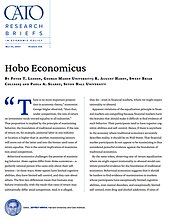Behavioral economics challenges the premise of maximizing behavior. Homo sapiens differ from Homo economicus—a perfectly rational person who cares only about their self-interest—in three ways: Homo sapiens have limited cognitive abilities, they have limited self-control, and they care about others. The first two differences mean that humans may behave irrationally, with the result that rates of return may substantially differ amid competition. And, it is alleged, they do—even in financial markets, where we might expect rationality to abound.
Apparent violations of the equalization principle in financial markets are compelling because financial markets have the features that should make it difficult to find evidence of such behavior. Their participants tend to have superior cognitive abilities and self-control. Hence, if there is anywhere in the economy where traditional economics accurately describes reality, it should be on Wall Street. That financial-market participants do not appear to be maximizing is thus considered powerful evidence against the foundation of traditional economics.
By the same token, observing rate-of-return equalization where we might expect irrationality to abound would constitute powerful evidence for the foundation of traditional economics. Behavioral economics suggests that it should be hardest to find evidence of maximization in markets whose participants have exceptionally limited cognitive abilities, even mental disorders, and exceptionally limited self-control, even drug and alcohol addictions. If rates of return nevertheless tend toward equality in these markets, then perhaps maximization is a more robust foundation for economics than behavioral considerations suggest.
We study such a market: the market for panhandling. Panhandlers are people who solicit donations from passersby in public spaces. Mental and substance disorders are highly prevalent among panhandlers, who therefore allegedly cannot all be comfortably categorized as rational decisionmakers.
We collected data on the number of panhandlers at 26 Metrorail stations in Washington, DC, and on hourly panhandling receipts at 5 of those stations. Metrorail is Washington’s public rapid-transit system. Panhandlers solicit passersby outside its station exits. Some Metrorail stations are trafficked by more passersby and thus offer more panhandling opportunities. If panhandlers respond rationally to incentives, such stations should attract more panhandlers. And if panhandlers’ station choices are maximizing, panhandling rates of return across stations should tend toward equality.
We find that stations with more panhandling opportunities attract more panhandlers and that cross-station differences in hourly panhandling receipts are statistically indistinguishable from zero. Panhandling rates of return thus tend toward equality. Extreme behavioral traits, in other words, do not prevent maximization in this market. Panhandlers choose stations as Homo economicus would if Homo economicus were a street person who solicited passersby at Metrorail.
NOTE
This research brief is based on Peter T. Leeson, R. August Hardy, and Paola A. Suarez, “Hobo Economicus,” Economic Journal 132, no. 646 (August 2022): 2325–38.

